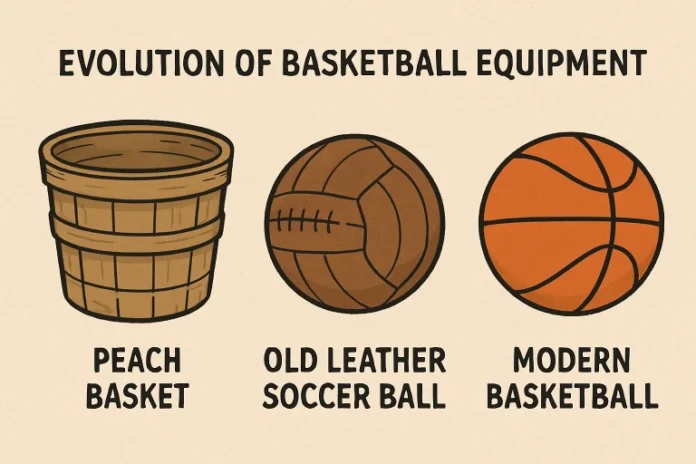Basketball is a dynamic sport with a rich history that continues to inspire new generations of athletes. Its evolution is evident in youth girls basketball, which shapes the game’s future. Basketball’s history is characterized by innovation and cultural impact, going beyond the court. This evolution is reflected in the introduction of game-changing equipment, the development of international leagues, and the rise of grassroots programs like youth girls’ basketball. The journey of basketball is filled with inspiring and surprising stories, showcasing the sport’s continued growth and impact on the global stage.
Table of Contents
Origins of the Game
Basketball was created in December 1891 by Dr. James Naismith, a Canadian physical education instructor, to keep students active during a harsh Massachusetts winter. He made 13 simple rules using a soccer ball and two peach baskets. The first game, played at the Springfield YMCA, had a 1-0 score, demonstrating the sport’s evolution over time. The original rules were less injury-prone than football but still engaging and competitive. Players advanced the ball only by passing, and peach baskets retained their bottoms, unlike modern fast-paced games.
Evolution of Equipment
Early basketball games looked dramatically different from the matches we see today, not just in style but also in the equipment used. The switch from soccer balls to the sport’s first specifically designed basketballs made gameplay smoother. Meanwhile, the closed-bottom peach baskets were replaced by open nets in 1906, which allowed the ball to fall freely after each score, thereby enhancing game flow and excitement.
Significant technological improvements have continued up through the years—from high-performance synthetic basketballs to advanced court surfaces that help reduce injury risks. The sport’s evolution in equipment is ongoing, as seen in innovations such as the shot clock and modern video replay systems.
Rule Revolutions
Rules in basketball have constantly evolved to keep the game engaging and fair. In 1897, the act of dribbling was officially introduced, marking the start of a new era in skill and strategy. This key change not only made the game faster but also gave rise to the artful ball-handling seen in professional leagues.
One of the most transformative regulatory changes was the introduction of the 24-second shot clock in 1954, developed to prevent stalling tactics and speed up play. This shift injected new energy into the game and is credited with making professional basketball a must-watch spectacle. Periodic rule changes—notably the three-point line’s debut in the late 1970s and the expansion of goaltending violations—continue to foster creativity and maintain basketball’s appeal.
Pioneering Players and Teams
Certain figures and teams have left an indelible mark on basketball. The Harlem Globetrotters, formed in 1926, offer perhaps the greatest example of using showmanship to promote both the sport and social change, as they were instrumental in bringing basketball to mainstream audiences and breaking racial barriers. Their influence highlighted the game’s entertainment value and played a part in expanding its global footprint.
Players like Bill Russell, Michael Jordan, and Lisa Leslie have set benchmarks for excellence while inspiring youth participation and growth in leagues across genders and backgrounds. Today, new stars continue to shape the future and break records, further diversifying basketball’s legacy.
Cultural Impact
The significance of basketball reaches beyond the scoreboard. The sport has influenced music, art, fashion, and language. Popular expressions like “slam dunk” or “buzzer beater” have even become part of everyday conversation. The NBA’s partnership with artists, musicians, and clothing brands illustrates basketball’s pivotal role in shaping popular culture. Basketball’s cultural influence is felt strongest in urban communities, serving as a positive outlet and connector among diverse groups—fueling stories, movements, and lifelong passions.
Technological Advancements
Technology’s role in basketball extends far beyond the court. Instant replay was introduced in 2002 for game-defining moments, transforming officiating and improving fairness. Additionally, the use of advanced data analytics has redefined coaching, allowing teams to study player efficiency, shooting patterns, and defensive strategies in minute detail. These advancements continue to make basketball smarter and more competitive.
Unusual Records
While championships and skills captivate fans, it’s the quirky achievements that often capture the imagination. The NBA’s longest game—played on January 6, 1951, between the Indianapolis Olympians and the Rochester Royals—stretched for 78 minutes over six overtimes, ending 75-73. Such feats are reminders of basketball’s unpredictable drama and unwavering excitement.
From record-busting three-pointers to marathon matchups, the sport’s history is rich with stories that testify to the athletes’ commitment and the game’s ever-changing nature. Basketball’s journey is a story of creative invention, social progress, and global unity—continually evolving as new players, leagues, and fans shape its future, both on local playgrounds and the world’s grandest stages.
Also Read: How to Choose the Perfect Flower Arrangements for Your Even
Final Thoughts
Exploring the fascinating and fun facts from basketball’s history reveals just how much the sport has evolved while keeping its spirit alive. From its humble beginnings with a peach basketball to today’s high-energy global competitions, each story adds depth to the game we know and love. By understanding its past, fans and players alike can better appreciate the traditions, innovations, and personalities that have shaped basketball into the thrilling sport it is today—and will continue to be for generations to come.
